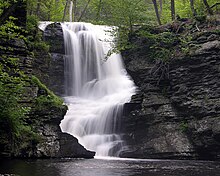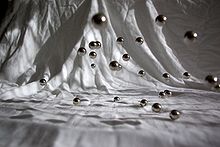Exposure time

The exposure time (or exposure time , English exposure time ) is the time period in which a photosensitive medium (z. B. film in conventional cameras , CMOS or CCD sensor in digital cameras ) is exposed for recording an image to the light. In photography , the exposure time (or exposure time) is often given as "1/15 s", "1/30 s" (s for second). Together with the f-number , the exposure time determines the amount of light incident on the medium ( exposure value , EV ). Correct exposure of the medium depends on the brightness of the subject, the amount of incident light and the sensitivity of the medium ( ISO , ASA or DIN number). With a given subject brightness and sensitivity, only a certain amount of light gives the correct exposure. Too short an exposure time leads to underexposed (too dark) images, too long to overexposed images, whereby the tolerance is around 30%. However, incorrect exposures can sometimes be corrected in the darkroom or through digital image processing .
Shutter speed
The exposure time is set as the shutter speed on the camera - or implemented in another suitable way if the desired exposure time is outside the possible shutter speeds of the camera. The necessary exposure time becomes shorter with stronger incidence of light (brightness) and with increasing light sensitivity of the image sensor ( ISO number - the higher, the more light-sensitive). Is determined the correct exposure time with a (mostly in-camera) light meter .
Range of values
The exposure time can range from fractions of a second to hours, depending on the technology used. For extremely short times (less than approx. 1/5000 s) we speak of short-term photography , for times of over approx. 5 s we speak of long-term exposure (especially for night photos, microscopic photos, astrophotography). The short-term effect must be observed for very short exposure times , and the Schwarzschild effect for very long exposure times, especially when taking pictures on film .
Blurring, motion blur
Exposure times that are too long can lead to blurred (“shaky”) images. The exposure time required for a sufficiently sharp result can be extended by various measures: use of a tripod , shorter focal length of the lens, image stabilization or lower resolution of the image . The longer the focal length of the lens, the smaller the image angle shown and the greater the influence of a change in the angle of the camera within the exposure time.
For cameras with 35mm film, the rule of thumb for handheld shots is that the exposure time should not be longer than the reciprocal of the focal length. With a 50 mm lens on the 35mm camera, the exposure time should not exceed approx. 1/50 s (usually 1/30 or 1/60 second can be set), with a 500 mm lens it should not exceed approx. 1/500 s. For cameras with smaller sensors, the rule of thumb is that the exposure time from a free hand should not be longer than the reciprocal of the [focal length] × [format factor], at 50 mm and a factor of 1.5 that is 1/75 s. According to the shutter speed series, the photographer can choose between 1/60 and 1/125 second, with 1/125 being a safe value. Please note that this rule of thumb is intended for prints that are viewed at least at the distance of the image diagonal of the print.
If you have a very steady hand, you can still manage 1/10 to 1/20 of a second with a short focal length, especially with a touch shutter release . Several shots allow you to choose the sharpest. Without a tripod, it is useful to press your upper arms tightly against your body and briefly hold your breath when the trigger is released . With the camera on it, exposure times of over 1 second are possible.
The motion blur increases as does the risk of blurring with long exposure times , long focal lengths (and high format factors (crop factors) with the same focal length).
See also: snapshot
exposure
In addition to the f-number, the exposure time is the most important means of creating photographic works. It determines whether the propeller of an aircraft is shown as a blurred circle (longer exposure time) or as a propeller that appears to be stationary (short exposure time) (see also motion blur ). Conversely, desired apertures (in particular to create a certain depth of field ) generally enforce certain exposure times. Exceptions can be made by using special film sensitivities or gray filters .



